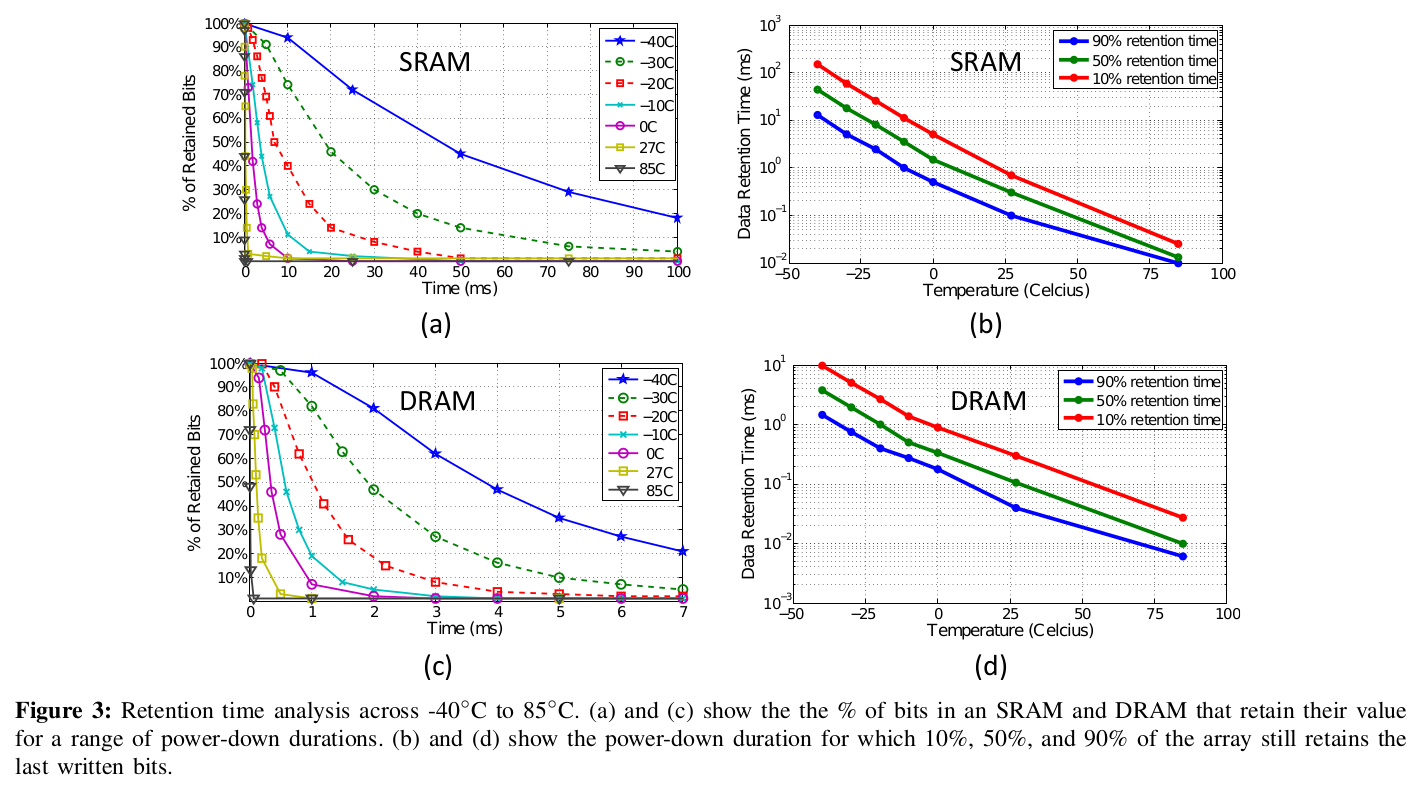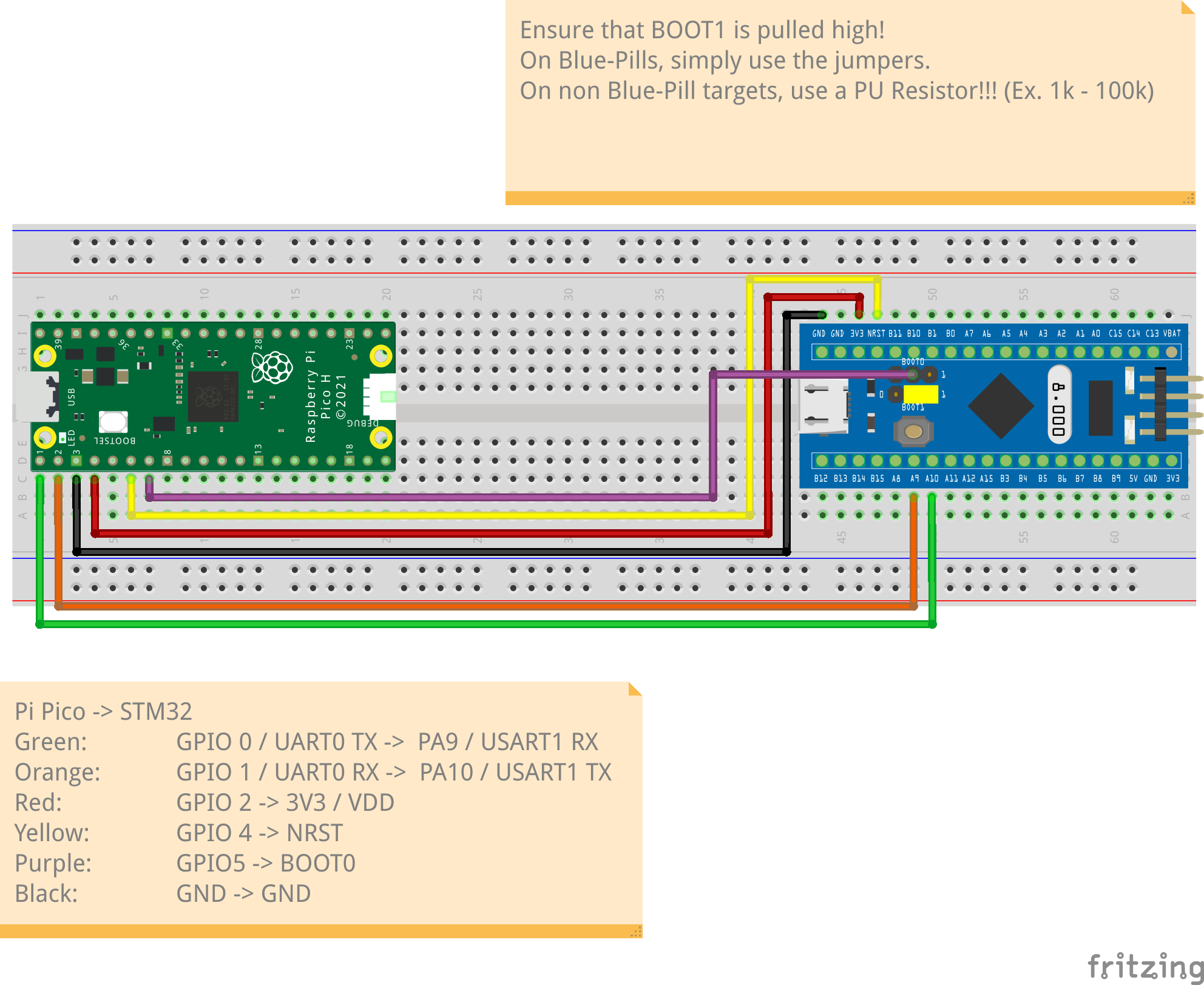A Pi Pico implementation of Johannes Obermaier's, Marc Schink's and Kosma Moczek's Glitch and FPB attack to bypass RDP (read-out protection) level 1 on STM32F1 chips.
The paper describing the attack can be found here along with its original implementation here
- A PC running Linux
- A Raspberry Pi Pico (or any other RP2040 devboard)
- A debug probe (e.g. a ST-Link V2)
- An STM32F1 target board (in this repo's case a RDP locked Blue Pill is used)
Please ensure the following dependencies are installed on your system:
Furthermore, install these additional dependencies if you intend to build the attack board and target board exploit firmware yourself:
The instructions also require that you have a basic understanding of how to build Pico SDK based projects. It also pre-supposes that you have a basic understanding of how to connect your Pi Pico and debug probe to your target STM32F1 board.
To get started, clone this repository and enter it:
$ git clone https://github.com/CTXz/stm32f1-picopwner.git
$ cd stm32f1-picopwnerIf you wish to skip the build process and just flash the attack firmware onto your Pi Pico, you can download the latest pre-built attack firmware from the releases page
Start out be entering the attack directory:
$ cd attackNext, edit the CMakelists.txt file to point to the location of your Pico SDK installation. For that you'll need to edit the following line:
set(PICO_SDK_PATH "/usr/share/pico-sdk")Replace /usr/share/pico-sdk with the path to your Pico SDK installation.
Next, create a build directory and run cmake and make:
$ mkdir build
$ cd build
$ cmake ..
$ makeIf everything went well, you should now have a attack.uf2 file in your build directory. Put your Pi Pico into bootloader mode and copy the attack.uf2 file onto it.
If you wish to skip the build process and just flash the target board exploit firmware onto your target STM32F1 board, you can download the latest pre-built target firmware from the releases page
The attack relies on the target STM32F1 board getting a exploit firmware temporarily flashed onto its SRAM. This firmware contains a two-stage exploit that will dump the target board's flash memory to the serial port upon completion.
To compile the target firmware, enter the target directory and run make:
$ cd target
$ makeBy default, this will build a target firmware that dumps to the STM32F1's USART1 peripheral. If you wish to dump the firmware to a different USART peripheral, you can provide usart1, usart2 or usart3 as an argument to make. For example, to build a target firmware that dumps to USART3, run:
$ make usart3Note: This is subject to change. In later revisions the USART peripheral will be selected at runtime.
This is particularly useful if the target device provides easier access to a different USART peripheral.
If everything went well, you should now have a target.bin file in your target directory. This file will be flashed onto the target board's SRAM during the attack.
Prior to connecting your Pi Pico to your target board, ensure that the BOOT1 pin (typically PB2, but please refer to your chips datasheet) on your target board is permanently set high by using a Pull-Up resistor (1k - 100k) to 3.3V. Neglecting to use a pull-up resistor to drive BOOT1 high can have severe consequences, potentially damaging the pin. This is because the BOOT1 pin is also used as a GPIO pin, and driving it as a low output without a pull-up resistor could cause a direct short.
Next, connect your Pi Pico to your target board as shown in the table below:
| Pi Pico | STM32F1 |
|---|---|
| GND | GND |
| GPIO0 / UART0_TX | USARTx_RX |
| GPIO1 / UART0_RX | USARTx_TX |
| GPIO2 | VDD |
| GPIO4 | NRST |
| GPIO5 | BOOT0 |
Where USARTx_RX and USARTx_TX are the RX and TX pins of the USART peripheral that the target firmware has been built for.
The USART pins for STM32F1-series chips are assigned as follows:
| USART Peripheral | RX | TX |
|---|---|---|
| USART1 | PA10 | PA9 |
| USART2 | PA3 | PA2 |
| USART3 | PB11 | PB10 |
Below is a picture that shows the hardware setup using a Blue Pill board as the target board with USART1 used to dump the flash memory:
- Begin by connecting connecting the Pi Pico to your PC via USB. Your Pi Pico as well as the target board should now be powered on.
Note: Depending on the target board, it may not be obvious whether the STM32F1 is powered on or not. One way to confirm that the targeted STM32F1 is receiving power is to check if the
NRSTpin is being pulled high. Another method to confirm whether the targeted STM32F1 is receiving power is to connect a debug probe without the 3.3V pin connected and check if communication through OpenOCD is possible.
Note: If you are confident that the power-related pins are connected correctly, but the target board still does not appear to be powered on, then the target board may be drawing too much current from the Pi Pico's GPIO. In this case, you will need to buffer the GPIO responsible for providing power (
GPIO2) with a BJT or MOSFET.
- Next, connect your debug probe (ex. ST-Link V2) to your target STM32F1 board.
- Create a new terminal window in the top of this repository and run the dump script:
$ python3 dump.py -p /dev/ttyACMx -o dump.binWhere /dev/ttyACMx is the serial port that your Pi Pico is connected to. If left unspecified, the script will attempt to use /dev/ttyACM0 by default.
dump.bin is the file that the target board's flash memory will be dumped to. If left unspecified, the script will not write the dump to a file and only
print its content to the terminal.
Note: If you decided to use a release binary instead of building the target firmware yourself, you will need to specify the path to the binary using the
-tflag or else the script will attempt to look for the binary intarget/target.binby default.
- From this point on, simply follow the instructions printed by the script.
If the dump script worked, you should now have a complete dump of the target board's flash memory in the dump.bin file (or whatever you named it).
Please note that it is normal for the dump to contain a lot of 0xFF bytes at the end due to unused flash typically being erased to 0xFF.
Should the dump script time out and fail, it could be the result of one of the following issues:
- The debug probe is still connected to the target board
- The
BOOT1pin on the target board is not set high - The Pi Pico has not been connected properly to the target board (Ensure the GNDs are connected!)
- The Pi Pico has not been flashed with the attack firmware
- The wrong USART peripheral was selected when building the target firmware
- The SRAM entrypoint address is different for your STM32F1 chip (Please refer to this issue until different entrypoint addresses are integrated into the script)
- The power draw of the target board is too high for the Pi Pico to handle (Try buffering the power pin with a BJT or MOSFET)
- The power board has a too high capacitance on the power and/or reset pins (Try removing any power and/or reset capacitors)
- The STM32F1 board is not genuine or maybe too new (there are rumors that the exploit has been patched in 2020+ revisions of STM32F1 chips)
Due to the attacks complexity, we must first introduce a couple of the STM32F1's properties that make the attack possible.
Given that this whole repository is about circumventing RDP Level 1, we will skip explaining the difference between RDP Level 0, 1 and 2 (does not apply to F1 chips) and instead focus on the properties of RDP Level 1 that make the attack possible.
When RDP Level 1 is set, the device will lock down access to flash memory as soon as either of the following conditions are met:
- Condition 1: A debug probe is connected to the device
- Condition 2: The device is booted into System Memory Mode (
BOOT0pin is set high,BOOT1pin is set low), aka. "Bootloader Mode" - Condition 3: The device boots from SRAM (
BOOT0andBOOT1pins are set high), starting execution at address0x20000000
It is important to know, that the read-out protection lock caused by condition 1 will persist even after the debug probe is disconnected and even after a device reset has occurred! In other words, it persists until the next power cycle after the probe has been disconnected. The read-out protection lock caused by condition 2 and 3 will only persist until the next device reset.
As we'll see later, the attack uses a glitching exploit to ridden the lock of condition 1 and then uses a 2-stage firmware exploit to get rid of the locks caused by condition 2 and 3.
The Arm Cortex-M3 (which the STM32F1 series uses) features something called the Flash Patch and Breakpoint Unit (FPB). The FPB possesses comparators that enable the setup of "patches" which redirect execution to a specified address when a particular memory address is accessed. It is important to know that these "patches" conveniently persist even after a device reset. Furthermore, the FPB lacks protection, allowing it to be configured even from code executed in SRAM.
The FPB is used in the attack to trick the device into executing code from SRAM when it supposed to execute code from flash memory. More details on this will be given further below where we discuss the whole attack in detail.
A critical part of the attack is the ability to execute exploit code from SRAM. Unlike flash memory, the contents of SRAM are lost as soon as the device loses power. Well, see, this is not entirely true. The SRAM of the STM32F1 suffers from data retention which means that the contents of SRAM will persist for a very short period of time even after the device loses power.
 Example of measured data retention conducted on 6T SRAM and 3T DRAM in 65mm bulk CMOS.
Source
Example of measured data retention conducted on 6T SRAM and 3T DRAM in 65mm bulk CMOS.
Source
This property of the SRAM will be exploited in the attack to preserve SRAM contents even after power cycling the STM32F1 in order to ridden the RDP lock caused by the debug probe.
The last part that needs a separate explanation is the 2-Stage exploit firmware that will be loaded into the STM32F1's SRAM. The code for the target exploit firmware can be found in the target directory.
The initial phase of the exploit firmware involves configuring the FPB (Flash Patch and Breakpoint unit) to intercept the retrieval of a reset interrupt. This is achieved by patching the reset vector fetch located at 0x00000004, thus redirecting the execution flow to the entry point of the exploit firmware's second stage. Consequently, when the STM32F1 is reset and set to boot from flash memory, the RDP lock is effectively removed and since a reset interrupt triggers a reset fetch, the execution immediately proceeds to the second stage entry point situated in the SRAM. In short, stage one cleverly deceives the STM32F1 into executing code from the SRAM instead of its intended execution from flash memory.
By the time stage-2 has been entered, the read-out protection has been completely circumvented. The second stage of the exploit firmware simply reads and dumps the contents of the flash memory to the serial port, where it is then read by the Pi Pico and further directed to the host computer via USB.
With all of the above explained, we can now finally explain the attack in detail. The steps below assume the hardware setup described in the Hardware Setup section.
During the first step, the debug probe is connected to the target STM32F1 board. This will cause condition 1 of the RDP lock to be triggered. The debug probe is then used to load the exploit firmware into SRAM and is then disconnected from the target board. As already mentioned above, condition 1 of the RDP lock will persist until the device is power cycled!
The goal here is to get rid of the RDP lock caused by condition 1, as well as booting into SRAM. To achieve this without wiping the exploit firmware from SRAM,
we will use a power glitching attack. The attack board (Pi Pico) will first prepare BOOT0 high and then toggle the power of the target board off. After switching the
power off, the attack board will monitor the NRST pin's logic state and immediately restore power once it the NRST pin drops low. Due to the short time it takes for
the NRST pin to drop low, the SRAM contents will remain preserved (due to data retention) and the STM32F1 will boot into SRAM since BOOT0 and BOOT1 are now both
high. The RDP lock caused by condition 1 will also be ridden since the debug probe is not connected to the target board any more and a power cycle has occurred.
The STM32F1 is now booted into SRAM and the exploit firmware's first stage is executed. Although we have gotten rid of the RDP lock caused by condition 1, we are now faced with the RDP lock caused by condition 3. As already described above, the first stage of the exploit firmware will patch the reset vector fetch address to jump to the second stage of the exploit firmware. Once the patch has been applied, the attack board pulls the BOOT0 pin low and resets the target board using the NRST pin. The STM32F1 will receive a reset interrupt and execute a reset vector fetch which will cause it to jump to the second stage of the exploit firmware. Simultaneously the rdp lock caused by condition 3 has been ridden since the STM32F1 believes is now booting from flash memory again (BOOT0 is low).
The STM32F1 is now executing the second stage of the exploit firmware. The second stage simply reads and dumps the contents of the flash memory to the serial port, where it is then read by the Pi Pico and further directed to the host computer via USB. Once the dump is complete, the exploit firmware will stop sending data to the serial port and the attack is complete.


